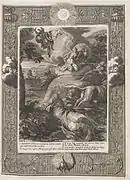The Weasel and Aphrodite
The Weasel and Aphrodite (Ancient Greek: Γαλῆ καὶ Ἀφροδίτη),[lower-alpha 1] is one of Aesop's Fables, numbered 50 in the Perry Index. A fable on the cynic theme of the constancy of one's nature, it serves as a cautionary tale against trusting those with evil temper, for even if they might change their body, they will not change their mind.[2]
| The Weasel and Aphrodite | |
|---|---|
 Grandville's illustration to La Fontaine's fable | |
| Folk tale | |
| Name | The Weasel and Aphrodite |
| Also known as | The Cat and Aphrodite |
| Aarne–Thompson grouping | ATU 212A (The Transformed Weasel)[1] |
| Region | Greece |
The story
A weasel fell in love with a young man, and begged the goddess of love, Aphrodite, to transform her into a human woman. Aphrodite, touched, did so, and turned the weasel into a exceedingly beautiful woman that every man would be lucky to have. The young man fell in love with the weasel, and soon they got married. As the woman sat in the nuptial bedroom, Aphrodite wished to test whether she truly was a human now or still retained an animal's nature at heart, so she released a mouse. Sure enough, the woman leapt out of the bed and caught the mouse to eat it. Aphrodite was angered, for she knew now that the weasel had not changed her ways at all upon becoming a woman. So, she turned her back into a weasel.[2][3][4]
To this is related an idiom related by Zenobius, "the wedding dress does not fit the weasel", which directly references the Aesopian fable;[5][4] compare the modern Greek word for weasel, νυφίτσα, which literally translates to "little bride."[6]
Other versions
Shorter is the version recorded by Babrius, who has the woman chase the mouse during the very nuptial feast, thus bringing the wedding to an end. Babrius does not state that Aphrodite released the mouse, instead writing that "[a]fter having played his little joke, Eros took his leave: Nature had proved stronger than Love."[7][4]
Notes
- Sometimes translated as a cat instead of a weasel.
References
- Hansen 2019, p. 472.
- Adrados 1999, p. 70.
- Aesop, Fables 88
- Johnston, Mastrocinque & Papaioannou 2016, p. 425.
- Zenobius 2.93
- The American Heritage Dictionary of the English Language s.v. marten
- Aesop fable 350 [= Babrius 32]
Bibliography
- Adrados, Francisco Rodríguez (1999). History of the Graeco-latin Fable: Inventory and documentation of the graeco. Leiden, the Netherlands: Brill Publications. ISBN 90-04-11891-8.
- Hansen, William (October 29, 2019). The Book of Greek and Roman Folktales, Legends, and Myths. Princeton and Oxford: Princeton University Press. ISBN 978-0-691-19592-6.
{{cite book}}: CS1 maint: date and year (link) - Johnston, Patricia A.; Mastrocinque, Attilio; Papaioannou, Sophia (August 17, 2016). Animals in Greek and Roman Religion and Myth. Cambridge Scholars Publishing. ISBN 978-1-4438-9487-6.
{{cite book}}: CS1 maint: date and year (link)
.jpg.webp)
.jpg.webp)
